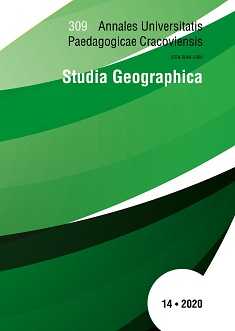Demographic typology of communes in Małopolskie voivodship in 1986–2016
DOI:
https://doi.org/10.24917/20845456.14.8Keywords:
demography, commune, population, city, rural area, typologyAbstract
Małopolska makes a good example of changes observed in the country due to the large differentiation of socio-economic processes. Depopulation types of communes as well as permanently growing ones can be observed there. Different demographic trends can be noticed in rural and urban areas. Cities seem to copy the general trends more often.
The aim of the paper is to give the typology of all communes of the Małopolska province in terms of population growth. Chosen method by J.W. Webb (1963) allows for synthetic analyze of both natural and migration growth and for typology of communes. The analyze was given for 1986-2016 based on eight types of Webb typology.
References
Bański, J. (2008). Wiejskie obszary problemów demograficznych. W: Wybrane zagadnienia systemów informacji przestrzennej i obszarów problemowych rolnictwa w Polsce, Studia i Raporty IUNG-PIB, 12, Program wieloletni 2005–2010. Puławy: IUNG.
Długosz, Z. (2001). Próba dynamicznej typologii ruchu ludności w świetle klasyfikacji Webba na przykładzie województwa małopolskiego. W: B. Kortus (red.), Człowiek i przestrzeń. Kraków: IGiGP UJ, 61–70.
Długosz, Z., Kurek, S. (2009). Stan, przemiany i perspektywy starzenia się ludności na obszarze Karpat Polskich. W: Z. Górka, A. Zborowski (red.), Człowiek i rolnictwo. Kraków: IGiGP UJ, 161–170.
Flaga M. (2008). Zmiany zaludniernia na obszarach wiejskich woj. lubelskiego po roku 1989. Annales UMCS, Sec. B, 57
Gawryszewski A. (2007). Zmiany w rozmieszczeniu, ruchu naturalnym, migracjach i strukturze ludności Polski, 1918–2005. Przegląd Geograficzny, 79, 3–4.
Kurek S. (2008). Typologia starzenia procesu starzenia się ludności miast i gmin Polski na tle jego demograficznych uwarunkowań. Przegląd Geograficzny, 79, 1.
Kwiatek-Sołtys A. (2005). Małe miasta woj. małopolskiego na przełomie XX i XXI wieku. Biuletyn KPZK PAN, z. 220.
Kwiatek-Sołtys A. (2017). Własność gruntów, a poziom rozwoju małych miast w Polsce, ujęcie typologiczne. Kraków: Wydawnictwo Naukowe Uniwersytetu Pedagogicznego.
Pięcek B. (2007). Wiejskie obszary wyludnienia w Polsce. Wiadomości Statystyczne, 12.
Potrykowska A. (2007). Przestrzenne zróżnicowanie sytuacji demograficznej w Polsce. Tendencje i perspektywy. Przegląd Geograficzny, 79, 3–4.
Prochownik A. (1965). Przemiany struktury osadniczo-agrarnej wsi powiatu proszowickiego od połowy XIX wieku do 1960 roku (na wybranych przykładach). Dokumentacja Geograficzna, z. 6.
Rosner A. (2012). Zmiany rozkładu przestrzennego zaludnienia obszarów wiejskich. Wiejskie obszary zmniejszające zaludnienie i koncentrujące ludność wiejską. Warszawa: IRWiR PAN.
Soja M. (2008). Cykle rozwoju ludności Karpat Polskich w XIX i XX wieku. Kraków: Wyd. Instytutu Geografii i Gospodarki Przestrzennej UJ.
Uliszak R. (2013). Wizja wsi małopolskiej – rok 2015 – spodziewane scenariusze zmian. W: Polska wieś w perspektywie długookresowej – ujęcie regionalne. Studia Obszarów Wiejskich, tom XXXI, Warszawa.
Webb J.W. (1963). The natural and migrational components of population changes in England and Wales, 1921–1931. Economic Geography, 39(2), 130–148.
Downloads
Published
Issue
Section
License
The submission of a paper to be published is synonymous with an agreement to transfer the copyright free of charge from the author to the publisher. The author also agrees to permit the publisher to publish the paper in printed form, open access online form, digital library form and other digital platforms with which the publisher has or will have a publishing agreement. Furthermore, the author agrees to not limit the number of copies that may be printed or issued by the publisher. In the case of co-authored papers, it is assumed that the corresponding author is authorized to represent the remaining co-authors in this respect. Authors are requested to sign a copyright declaration.

